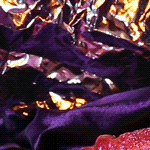About a month ago, I had the misfortune of discovering that my MacBook’s built-in camera had officially gone kaput. The cheapest solution, a $15 USB web camera that looked like a 2007 WIRED Staff Pick, led me to Target. And as I waited for the sales associate to dig out my camera from behind the orders counter, I kept myself busy by scanning the retail space until I came across something particularly intriguing—a Día de Muertos section.
I’ll be honest. My initial reaction was a mixed bag of amusement, judgment, and, frankly, genuine surprise. After all, I’ve always associated Target with white suburbia, so seeing this cultural display felt somewhat out of tune for me. But I nevertheless wandered over to inspect the small collection of festive decorations, which included items covered in calaveras and catrina designs, plus some miscellaneous choices like a Selena Gomez vinyl. I chuckled, dug around, nodded in approval, and eventually made my way.
Still, I left the store feeling a bit put off by the display, and not necessarily in a negative sense. For many first-generation Mexican-Americans, like myself, or immigrants, seeing aspects of your culture gain mainstream popularity can be a confusing experience. If you’ve struggled with feelings of otherness while assimilating into U.S. society, seeing this could maybe offer some relief or a conflicting sense of approval from your community. And then there’s the other side of you that harbors feelings of dread. For your entire life, your heritage has been a defining pillar of your identity, and seeing it reduced to merchandise, or reinterpreted for the American consumer, can be unsettling.
But before members of our community take the defensive against the commercialization of Día de Muertos, we should also ask ourselves if this holiday has already been reinterpreted, or rather misinterpreted, before? And are we the original perpetrators?

Target isn’t the first or only retailer to carry Día de Muertos merchandise, nor is the holiday’s mainstream exposure an overnight occurrence. Other retail giants like Walmart and Party City have their own selections of themed party supplies, decor, and T-shirts to attract Latine consumers. Blockbuster films like Coco and Spectrum have also played a role in carving out a place for the holiday, with the latter even inspiring a real-life parade in Mexico City that had only fictionally existed in the Bond flick. It can be argued that these moments are part of the next chapter for Día de Muertos as its festivities evolve alongside its new, wider audience. The traditions that originated in central Mexico are now being reinterpreted by Mexican-Americans, Chicanos, and even those who marry into the culture and pass it on to the next generation. Evolution, change, and cultural blending have always been, and continue to be, central to the essence of Día de Muertos.
But to further unpack this moment, it’s important to observe the holiday as a product of syncretism. When different cultures and religions are fused together to create something new, the final outcomes are always subject to debate or reinterpretation. One’s mind might quickly jump to the forced imposition of faith and societal structures during the times of European colonization, but syncretism still happens in varying degrees today. Whether from human migration, the assimilation of immigrant communities abroad, or the mass proliferation of information on the internet, we’ve all witnessed cultural mixing in one way or another.
Mexico and its rich heritage are in numerous ways products of syncretism and ideological clashes that brought forth cultural shifts. It was Spain and the Catholic Church committing atrocities against Indigenous people. It was Benito Juárez against conservative imperialism or the ideas of Zapatismo challenging the powerful grip of the Porfiriato. These conflicts and ideological crossroads are what fueled the (often tragic) origins of Mexican culture and identity. Día de Muertos is just one of these historical byproducts.

Today, the holiday is revered worldwide for its colorful festivities and beautiful take on death, with much of its traditional artwork now seen as synonymous with Mexican aesthetics. But this uniquely Mexican tradition has origins that still go ignored by those who celebrate it.
“But this uniquely Mexican tradition has origins that still go ignored by those who celebrate it.”
Over time, the holiday’s narrative has erased the mentionings of the soul’s journey to Chicunamictlán, the Aztecs’ Land of the Dead. We’ve forgotten how our ofrendas evolved from our Indigenous ancestors’ offerings to their loved ones as they journeyed through the nine levels of the afterlife, or how our use of copal incense and the presence of the four natural elements are all contributions from our Indigenous roots. We’ve forgotten how the War of Reform in 1860, with its separation of church and state, helped fuel the secularization of Día de Muertos and established it as a national tradition with vague ties to either Catholic or Nahua origins.
We must dig deeper than just surface-level aesthetics and ask ourselves how this holiday represents the complicated history of Mexican identity. Mexican identity has always been a tug-of-war between European and Indigenous origins, but the modern-day Mexican person shouldn’t have to choose. We should come to terms with our past, understand that we have been wronged but also that we too have committed cultural erasure or atrocities against certain communities. Fueling nationalism by shifting the focus to Indigenous culture is not the bandage that will heal our mistakes because these communities are more than just their art, music, and dance. They are entire economies, generations of families, language groups, and people who are systematically oppressed. As we continue to witness Mexican culture grow mainstream worldwide, we have to ask ourselves if we truly know who we are before we claim to be exploited or appropriated.

That’s not to say that major retailers or American corporations are perfectly capturing our heritage in their marketing campaigns and merchandise. There is work to be done. We still need to voice our concerns, condemn appropriation, and play a hands-on role in shaping how our community will leave a mark on this country’s cultural fabric for generations to come.
The conversation surrounding whether our culture is becoming too American, too Chicano, too Indigenous, or too European will never provide us the sense of security we’re looking for while trying to protect our national heritage, mainly because the Mexican experience is too diverse to settle on a single narrative. We can only continue doing what Mexicans have always done best: creating something beautiful out of new circumstances.




